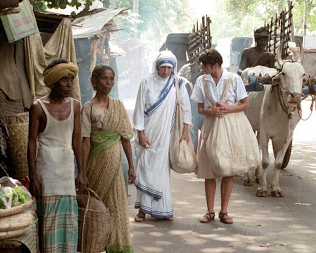 I can’t say I believe in canonization, but I do like Mother Teresa so I’ve awakened an old series on her that focuses (eventually) on her experience of darkness. (image)
I can’t say I believe in canonization, but I do like Mother Teresa so I’ve awakened an old series on her that focuses (eventually) on her experience of darkness. (image)
Some time ago and much to my delight, in the mail came the letters of Mother Teresa called Mother Teresa: Come Be My Light. The book stirred controversy because the depth and duration of her darkness became public.
We can’t understand Mother Teresa without viewing her through the lens of asceticism, something almost entirely foreign to Protestants and especially to American evangelicals. She joined a long, long list of Roman Catholics who have surrendered the pleasures of life — marriage and sexual relations, the comforts of a private life, the growth of income and savings, and the independence of making our own decisions.
Furthermore, as I’ve already witnessed on the internet, some Protestants (esp conservative evangelicals) have already rendered judgment on her eternal salvation. Not for me to judge. I want to look at her private writings to see what we can make of this extraordinary woman.
She was born Gonxha Agnes Bojaxhiu in Albania in 1910 and her native language was Serbo-Croatian. At twelve she knew she was called to the poor but it was not until she was 18 that she left home and went to Ireland to become a nun. Later she established the Missionaries of Charity. She later writes: “and since then [leaving home], this forty years, I’ve never doubted even for a second that I’ve done the right thing; it was the will of God. It was His choice” (14).
The introduction, by her editor and the director of the Mother Teresa Center, Brian Kolodiejchuk, M.C., emphasizes her desire that the letters and journals not be made public since they would attract too much attention to her and not to Jesus. And the introduction raises the issue of her “darkness.”
M. Teresa joined the Institute of the Blessed Virgin Mary (IBVM) called the Loreto Sisters and expressed over and over that her mission was to “save souls” or to bring Christ to souls and souls to Christ.
Already in 1937 (she was 27 years old), and just months before she took her vows, she said this to a Yugoslavian priest, her former confessor: “Do not think that my spiritual life is strewn with roses — that is the flower which I hardly ever find on my way. Quite the contrary, I have more often as my companion ‘darkness.’ And when the night becomes very thick — and it seems to me as if I will end up in hell — then I simply offer myself to Jesus” (20).
Here is what I see involved in M. Teresa’s darkness: her piety somehow must be involved. I would characterize it as radical self-denial, rigorous questioning introspection, perfection, radical discipline and three cardinal themes: service, sacrifice, and suffering. (But more later in this post.)
She made a vow in April of 1942 that I think shaped her life and her darkness: “I made a vow to God, binding under [pain of] of mortal sin, to give to God anything that He may ask, ‘Not to refuse Him anything’” (28). This vow to surrender all to God, regardless of what was being asked to be surrendered, led M. Teresa to a life that began the day and shaped the day and did not end until her strength was gone to give everything to God. Everything.
No matter how many other things might be involved, M. Teresa set herself up for a kind of burn-out from the very beginning of her apostolate to the poorest of the poor. I don’t have enough information to say this was the whole. But what I see is a piety driven by self-giving, self-sacrifice, and the need to enter into suffering in order to participate in the “thirst of Jesus”, the thirst Jesus had for the poor and for others to come to him.
M. Teresa lived in constant awareness not to let her “reverend I” become central.
M. Teresa said her sisters were to “be faithful in little practices of love, of little sacrifices” and she combined this with “responding immediately to the demands of the present moment” (34).
M. Teresa had a mystical encounter with Jesus on 10 Sept 1946 that led her from the convent in Calcutta to found the Missionaries of Charity, her apostolate to the poorest of the poor in Calcutta. This encounter with Jesus is where she heard “Come Be My Light,” the title of the book. This vision involved the thirst of Jesus for the poor; it involved his questioning of her “Will you refuse me?” and it involved calling her to identify completely with the poor and to go to the “holes of the poor” (44).
She confided much of this vision with her spiritual director, Father Van Exem, and it can be found in this book at pp. 47-52. (Very important pages I think.)
M. Teresa had the determination of a terrier, and chps 4-6 illustrate this over and over in the book.
Here’s the big picture. M. Teresa, to fulfill the mystical vision she got from Jesus about forming the Missionaries of Charity for the poorest of poor in Calcutta, had to get permissions at various levels:
Her vow as a Loreto sister had to be annulled since it was conventual.
Her spiritual director had to give her permission.
The Archbishop of India had to give her permission.
The Pope, or Rome, had to give her permission.
When she first told her director, Fr. Van Exem, he told her to keep the idea to herself for months. Then she was given permission to work with the Archbishop, a certain Perier. The latter simply wanted time to gain clarity of her motive and the will of God. He deliberated for a long, long time — about a year. Then Rome was slow and then she was saddled with some criticisms and some envy and some politics and it took a long, long time for her to have a vision and to establish a ministry.
The determination of M. Teresa is a powerful testimony of her will, her confidence in the vision, and her commitment not to let go until God had gained the upper hand. Her determination reflects her faith.
“Day after day,” she writes to the Archbishop, “hour after hour, He asks the same question: “Wilt thou refuse to do this for Me?” I tell Him that the answer is with you” (66).
The Archbishop both knew the power was in his hands and he knew as well that he had to discern God’s will for the missionary work in Calcutta. The time of testing drew out of M. Teresa clarity as to what the Missionaries of Charity would do: essentially they would sell out for God, their fires would burn for the missionary work to the poor, they would totally depend on God and identify with the poor.
Involved in this time of testing were some potent experiences of union with Christ. I think these times of union also influenced her perception of darkness: “There [where she was then residing] as if Our Lord just gave Himself to me — to the full. The sweetness & consolation & union of those 6 months passed but too soon” (83).
She speaks of a three-fold vision of being summoned by Jesus and the crowd of the poor to “Come,” of Mary’s words for her to “Bring them to Jesus — carry Jesus to them,” and a vision of darkness enveloping the crowd and words from Jesus and Mary to go to the crowd. “Will you refuse to do this for me?”
Once she gained approval, however, there were still challenges and tests. She got final permission from Rome on August 8, 1948. 9 days later, August 17, 1948, “clad in a white sari with a blue border, Mother Teresa … set out to begin a life as a Missionary of “Charity” (121). She chose to leave with just five rupees.
Mother Teresa’s launching of the apostolate called the Missionaries of Charity was an immediate success, in all the right ways. The story is found in chp 7 of her book of letters.
How often do we know the “inside” story — in both the sense of what is going on behind closed doors and what is going on in the heart of someone — as a successful story unfolds? Should we? How many know how hard it was for many to get ministries off the ground? How many have suffered dissension over the formation of ministries?
When she left the Loreto Sisters convent, here was her prayer:
O Jesus, only love of my heart, I wish to suffer what I suffer and all Thou wilt have me suffer, for Thy pure love not because of the merits I may acquire, nor for the rewards Thou has promised me but only to please Thee, to praise Thee, to bless Thee as well in sorrow as in joy.
She struggled even to find a place to say — rules of orders not permitting her to stay in monasteries or convents. She eventually found a place to rent. On December 21, she entered the slums of Calcutta. First day reflections:
“We started at Taltala and went to every Catholic family … children were all over the place … I spoke very, very little, I just did some washing of sores, and dressings, gave medicine to some… What poverty. What actual suffering.”
She was tempted to return; her legs ached from trying to find a place to stay. She suffered some “tortures of loneliness” (134). She fought tears.
Sister Agnes, at that time Shubashini Das, joined her. Within a year she had twelve sisters.
Students from her former convent started joining her and this caused dissension at the former convent.
The Missionaries of Charity finally received an official status and this was M. Teresa’s statement of their piety:
“Those who join this Institute, therefore, are resolved to spend themselves unremittingly in seeking out, in towns and villages, even amid squalid surroundings, the poorer, the abandoned, the sick, the infirm, the dying; in taking care of them, rendering help to them, visiting them assiduously and instructing them in Christian Doctrine, in endeavouring to the utmost to bring about their conversion and sanctification … AND in performing any other similar apostolic works and services, however lowly and mean they may appear” (139).
She was deeply devoted to Mary and to the Rosary. Then she formed a hospital of sorts called the “Treasure House” and founded “second selves” — others who would pray with them and suffer with them. By the end of 1952 there were 26 members and in February of 1953 they moved to a new home, still the administrative center of the Missionaries of Charity in Calcutta.
In 1953, M. Teresa wrote to the Archbishop these words: “Please pray specially for me that I may not spoil His work and that Our Lord may show Himself — for there is such terrible darkness within me, as if everything was dead. I has been like this more or less from the time I started ‘the work’.”
Now the big one: How to understand Mother Teresa’s darkness?
Here are some of the many, many statements about darkness she herself made, statements that contradict other statements of faith and love for God/Jesus during the same period. She lived a paradox of unflinching faith and steely obedience in the face of (perceived) emotional distance from God. (Part of this emotional distance has to be explained by the glory of her own emotional union with Jesus prior to her calling to the poorest of the poor. She had been to the mountaintop and nothing seemed to count after that.)
“How long will Our Lord stay away?” (158)
“for within me everything is icy cold” (163)
“The more I want Him the less I am wanted” (164)
“He is destroying everything in me” (169)
“no faith — no love — no zeal” (169)
“I understand a little the tortures of hell — without God” (172)
“I did not know that love could make one suffer so much — this is of longing — of pain human but caused by the divine” (180)
“The child of your love — and now become as the most hated one” (186).
“If there be no God — there can be no soul. — If there is no soul then Jesus — You also are not true” (193).
“I no longer pray” (193).
“I am perfectly happy to be like this to the end of life” (198).
“I have come to love the darkness” (208).
First I want to sort out how her spiritual advisors and how she saw her darkness.
First, what was her darkness? An emotional disconnect between her soul and God — involving her relationship to Jesus and to the Eucharist and to others. As I said on Monday, I think some of this is connected to her piety — with themes like self-denial, sacrifice and suffering shaping her consciousness — and even to emotional burnout, but this does not explain it adequately.
Second, her response was three-fold: blind faith in God regardless of what she felt and “smiles” that did two things — expressed visibly her faith and showed to others that suffering can be met with the loving smile of Jesus — and near total silence with all but three advisors.
Brian Kolodiejchuk, the one who has organized these letters and private writings into a whole for the Vatican (?), routinely “interprets” her darkness.
“Interior darkness was Mother Teresa’s priviledged way of entering into the mystery of the Cross of Christ” (156).
It was her participation in the (suffering) thirst of Jesus for souls.
It was a “veritable martyrdom of desire” (180).
Jesus “was living in and through her without her being able to savor the sweetness of His presence” (212).
An identification with Christ and with the suffering of others.
Archbishop Perier:
Suggested at least once she was fatigued (158).
Her experience is the dark night of the soul of the mystics (164)
Purification and protection against pride (167)
Fr. Joseph Neuner was the most helpful of all of her advisors:
“It was simply the dark night of which all masters of spiritual life know — though I never found it so deeply, and for so many years as in her” (214). [This is why I think it is unwise, unless prefaced and followed by lots of nuance, of calling M. Teresa’s darkness the dark night of the soul. It went on for too long.]
Here’s the statement of his that changed her life: “The sure sign of God’s hidden presence in this darkness is the thirst for God, the craving for at least a ray of His light” (214). And, “Thus the only response to this trial is the total surrender to God and the acceptance of the darkness in union with Jesus” (214).
Thus, her darkness was participation in the suffering death of Jesus. It was union with Jesus’ pain for others. It was this statement that led her to say she had come to love the darkness.
Mother Teresa:
“When outside — in the work — or meeting people — there is a presence — of somebody living very close — in very me” (211).
M. Teresa did not think her suffering was the dark night of the soul. “She had the intuition and now a confirmation from her spiritual director, that, though the sufferings were similar, their purpose was different” (218). She was not being purged; she was in union with the sufferings of Christ.
It took one step for her and others to see in her darkness the experience of Paul in Colossians: “in my flesh I complete what is lacking in Christ’s afflictions.”
One of her famous prayers and mantras: “Jesus I accept whatever you give — and I give whatever you take” (225). “If I ever become a saint — I will surely be one of ‘darkness.’ I will continually be absent from heaven — to light the light of those in darkness on earth” (230).
Now I’d like to (attempt to) put together how I understand her “darkness.” I have been asked about this wherever I’ve been and so, after reading the new book I’d like to post these thoughts. I only know what I have seen in the pages of her own writings.
She experienced her “darkness” as an emotional dryness. She said in 1967, after two decades of struggling with the darkness, this: “I know this is only feelings” (257). At the phenomenological level, as she says things herself, what she experienced was a lack of emotional bonding with God, with Jesus, with the Eucharist, with others, and even with the poor. This does not mean, it must be emphasized with utter clarity, that she came off as “flat.” In fact, M. Teresa worked at bringing the Smile of God into each situation. No one, other than those to whom she confided her darkness, knew about it. But her soul was dry in the sense that the glowing electricity of her former union with Christ never returned.
The experience of darkness led to a search for an explanation. This is natural. She asked “Why?” Her answers came in the form of theology and she baptized her darkness into the rhetoric of the cross. She tried to come to terms with the darkness as a suffering-with-Jesus. I would appeal to “attribution theory” to understand how she, and her confidants, explained her darkness. The darkness was so profound and so mysterious, they attributed the darkness to God. They came to see it as a gift from God to permit her to enter into the suffering of Christ. Personally, I’m not entirely convinced. The “dark night of the soul” explanation does not get to the bottom of it either. It was either a kind of dark night of the soul never experienced or that explanation is not enough.
I think we have to look to her context: M. Teresa’s darkness began at about the same time she entered into the slums of Calcutta. In my opinion, while all these theological explanations are explanations, attempts to put into words what she was experiencing by attributing it somehow to God, it does not seem to me that her supporters are fair enough with the emotional toll daily and constant contact with the poorest of the poor can put on a person. In part, and I have no reason to reduce it to this, her darkness is emotional shut-down because of the depth of the pain she was seeing in those around her. No one, I suppose, can encounter that much pain and not be stunned emotionally. Stunned to a profound degree. I don’t believe many could absorb that much pain. One way humans respond to such pain is deflect it but there is a price to pay for such. I believe that is in part a price M. Teresa paid.
Regardless of whether you agree with me or not, M. Teresa is a great example oftenacity. She had faith and she remained obedient no matter how she felt — and this is admirable in and of itself — and she becomes for these an heroic example of Christian faith.
As her life progressed the blessing of God was upon the work of the Missionaries of Charity. She won the Nobel Peace Prize, using those days to speak against abortion, and she had places in more than 77 countries with over 350 houses (in 1988).
Increasingly her theology of loving the poor became a theology of seeing Christ in the poor. “The Hungry One in the distressing disguise of the Poor” (279) and the famous line of Jesus’ … “you did it to me” when you did it to the least of these.
In a fitting parabolic end to her life, she died on September 5, 1997. As her life was coming to its end, the lights went out at the home and neither did the electric back-ups work. The whole house was in darkness and the one who was called by Jesus to be light to the dark holes of Calcutta died in darkness.




